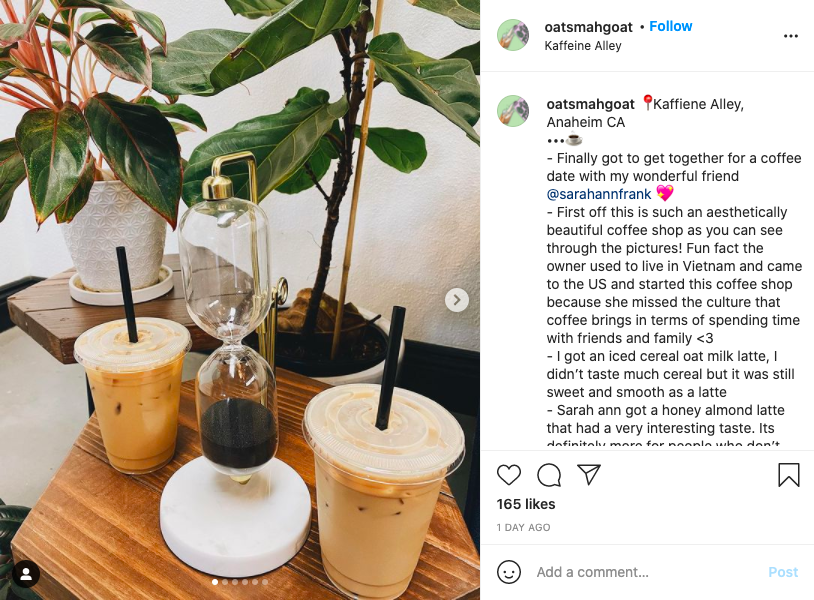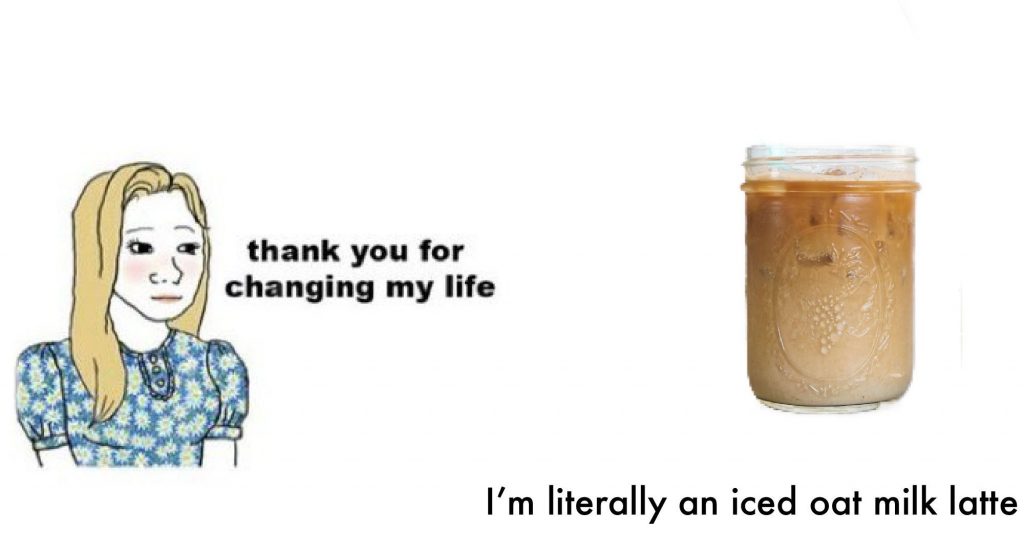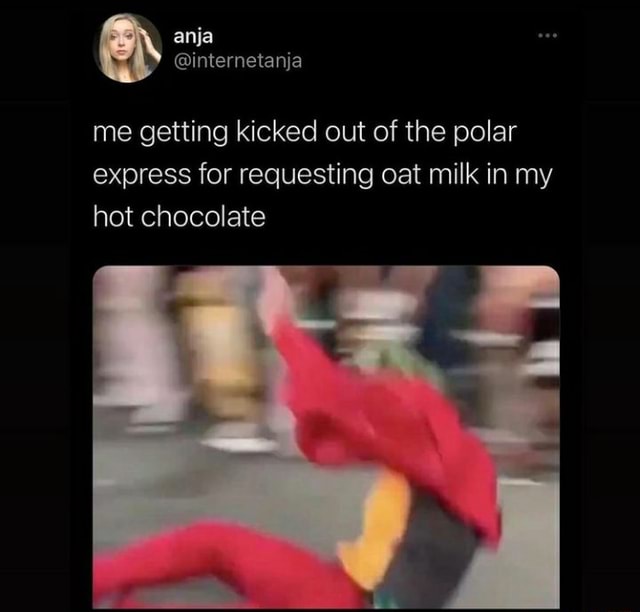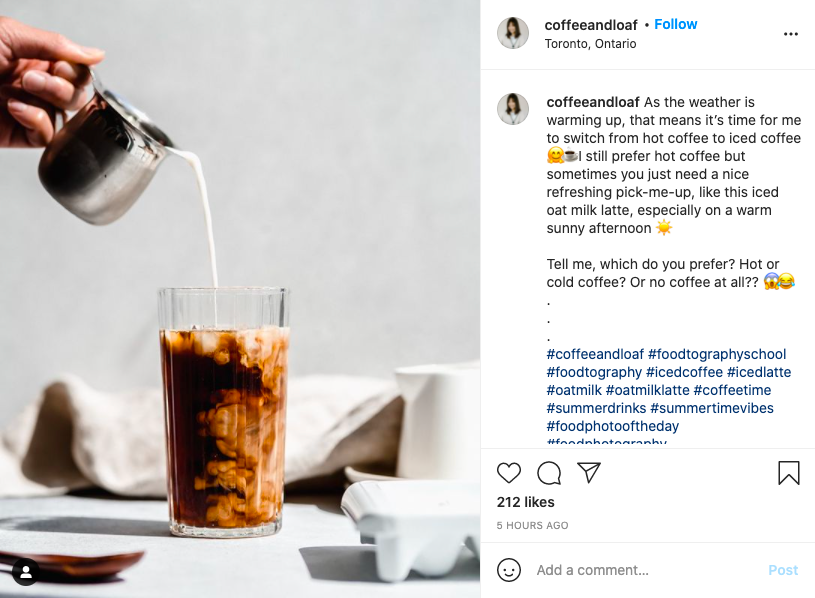At a Starbucks in downtown Los Angeles, a girl steps up to the cash register to order her drink. “Can I get a Grande Iced Latte with oat milk, please?” she says.
Carmen Williams, 21, has been ordering her beverages with the plant-based dairy alternative for years now. However, unlike most consumers of vegan milks, she does not have an intolerance for lactose, nor does she consider herself vegetarian.
Williams is one of the growing number of young people who exclusively drink vegan milks out of preference, and not out of necessity. “It’s like yeah, if someone forced me to drink dairy milk, I wouldn’t get sick or anything. But I would never choose to drink it,” she explained.
This appears to be a nation-wide phenomenon. Young people —usually in their late teenage years to mid-twenties— have started to drink oat milk not because they need to, but because they want to.
Why, you ask? Oat milk appears to be the latest marker of trendiness and style, used by Instagram “It girls” and high-end restaurants in Los Angeles. It is no longer just the drink of choice for the lactose intolerant, but a voguish indication of being in tune with the times. Oat milk has not only become the crème de la crème of all milks, but has also become something that its drinkers want to show off.
Its trendiness may have arisen for a variety of reasons, including the stylishness of environmentalism, the ascending popularity of health trends, or the fact that oat milk, indeed, actually tastes great. However, much of the beverage’s popularity can be linked back to its artistic portrayal on social media, and the thousands who have been influenced by it. Regardless of the reason, people are willing to pay the extra buck at their local coffeeshop to have it added to their drinks instead of cow’s milk.
What is oat milk and just how popular is it?
As its name suggests, oat milk is made mainly from oats. The process of ‘how’ to make it varies from recipe to recipe, but the basic way of making the beverage involves soaking oats in water and straining the liquid from the mixture. And there you have it— oat milk!
Since it was originally intended to substitute dairy milk, oat milk is used in all kinds of recipes that call for heavy cream or whole milk. However, it has been popular among baristas, and has been used frequently in coffee or teas.
At its inception in the late 1990s at Lund University, oat milk was nothing special, and there was no market for it. However, when the Swedish university’s researchers arrived in the United States in 2017, they brought with them Oatly, and the American cultural landscape changed forever.
Oatly has become a favorite brand among retailers, used by Starbucks and Blue Bottle Coffee. Its popularity can be seen in the numbers—Last summer, Oatly was reportedly valued at $2 billion, and its sales have only skyrocketed since its arrival in the United States. Most recently, the company has even been backed by celebrity talk-show host Oprah.
More broadly, plant-based milks have increased sales by over 27 percent in the last two years, according to data from the Plant Based Foods Association. Vegan milks are now the most popular type of plant-based food, bringing in at least $2.5 billion in 2020, the agency reported.
Social Media and its Impact
If you look under #oatmilk on any social platform, thousands of recipes that involve the drink will appear. At the time this article was written, the hashtag had over 366,000 posts on Instagram, highlighting the world’s love for the beverage. Thousands of pictures of latte art, homemade refreshments, and coffee shops reside within the hashtag.
Evidently, these posts have a wide reach. Williams, like many, was first influenced by social media to try the beverage.
“I was actually first introduced to oat milk a few years ago because —as weird as it sounds— I saw some girl on my Instagram drinking it with her coffee so I wanted to try it because it sounded good,” she said. “When it first started getting popular a few years ago, I saw lots of coffeeshops and even just random people posting pictures of their milk lattes on Instagram. Naturally I wanted to see what the hype was about.”
Williams’ behavior is in line with the science behind Instagram influencer persuasion, according to Forbes’ “The Psychology of Influencer Marketing.” It is only natural to want to participate in a trend or to mimic someone after seeing their posts, the article concludes.
Giovanni Truglio, a 21-year-old based in Honolulu, Hawai‘i, echoes the same sentiment. He says he tried oat milk for the first time “definitely within the past year or so” because “I just kept seeing it on people’s Insta Stories.”
“I always used to see it in Whole Foods but never really tried it. And then one day I just decided to try it after seeing it on social media,” he explained.
“I feel like whenever you see something new on social media or something that’s kind of going viral or blowing up it’s like, ‘Oh I want to try that!’” he said. “I just hopped on the trends like okay, everyone’s doing it and so I guess I kind of like jumping on the bandwagon.”
Truglio added that the appeal of oat milk is a result of how fashionable it looks on the internet. “Oat milk content is always just really artsy and an aesthetic, whereas other milks aren’t as present on social media, if that makes sense,” he said. “The pictures that I see of oat milk are always in this minimalist style, it just makes you feel like whoever is drinking that has their life together or something…It’s like, definitely a status symbol, like kind of a flex to drink oat milk.”


The Starbucks Example
Earlier this year, Starbucks became the latest coffee shop to announce its addition of oat milk to the menu. Once news broke, social media blew up. “This is not a drill. Starbucks is launching oat milk nationwide in March,” a Starbucks worker announced in a TikTok.
With over 47,000 likes, the video excited many. User knemeczky commented, “ABOUT TIME I haven’t been going as much cause of that.” “I’m sobbing of joy,” user stelfra commented.
Once it did arrive at the coffee chain, social media platforms once again exploded with thousands of videos about new possible menu items and recommendations for orders. When the “Iced Brown Sugar Oatmilk Shaken Espresso” became available for purchase in early March, hundreds of social media users posted reviews of the drink and along with it, their enthusiasm for the oat milk used in it. “I can totally taste the brown sugar. Love the oat milk… That’s a win,” says Brittani Lancaster, in her TikTok.
Williams was one of the many who ordered the beverage within the first few days of its launch. “Its so funny because I didn’t even know about it at first until I saw it on TikTok, and I pass by Starbucks everyday. TikTok does a better job at advertising their drinks than Starbucks does,” she said.
The Iced Brown Sugar Oatmilk Shaken Espresso was so popular, that just a month after it did hit stores, a shortage of oat milk was reported across Starbucks’ nationwide, attesting to the beverage’s popularity. The article mentions a person who was not able to receive oat milk in their order due to the shortage. “Just throw my whole drink away tbh,” they tweeted, referencing the dairy milk that they received in their drink instead.
If oat milk is in, dairy milk must be out…
As oat milk began its ascent into chicness, more and more young people have started to distance themselves dairy milk. Many TikTokers have contributed the narrative that cow’s milk is indeed, officially out of style.
A TikTok with over 55,000 likes explains this. In the video, TikToker Audrey Peters explains “what your choice of milk says about you.”
“First of all, notice how everybody is very particular about their choice of milk. Nobody’s just like ‘Oh yeah, pick my milk for me’ when they order,” she says.
“If your choice is any kind of animal milk, you’re definitely a boomer that refuses to believe that it’s bad for you,” she says. “If there is one thing I know for certain in life, it’s that the person that drinks oat milk let’s everybody know that they drink oat milk.”
Another TikToker, user stephen_brower, makes a similar statement in his video. “[If you drink oat milk,] you’re on trend. You have good taste with a god complex you can smell a mile away,” he jokes. Later commenting on skim milk drinkers, he says, “That’s self-inflicted emotional abuse. How?”
Truglio says he has seen videos on social media similar to the one aforementioned. “I feel like dairy milk is definitely becoming more obsolete and it’s almost like a social thing,” he said. “Drinking dairy milk, it’s like, similar to having an Android versus an iPhone. There’s a little bit of shaming involved, you know.”
A cultural obsession
As oat milk made its way into popular culture, somewhere along the way, it has turned into a cultural obsession, igniting communities online and becoming a marker of a specific identity.
On Facebook, a group called Oat Milk Lovers has become the home of discussion related to all things concerning the drink. A post on Reddit outlines a definitive ranking of oat milks, garnering over 200 comments that agree or disagree with the listing of different brands.
Over on TikTok, the widespread passion for oat milk is more apparent. Users have gone as far as making the milk part of their username, with credentials like @oatmilkleader, @oatmilkbimbo, @oatmilkfan2.
And the oat milk craze does not end there—people are selling customized oat-milk themed shirts and earrings on the popular craft website Etsy. Some shirts for sale have texts that read, “iced latte with oatmilk” and “My oat milk brings all the boys to the yard” emblazoned on them.
Entering meme world



And if vegan merchandise were not enough, maybe internet memes are. Oat milk has officially made its way into the ‘funny’ side of the internet, surfacing on humorous photos and other funny videos that have been shared by thousands.
In one meme found on Twitter, a girl says, despondently, “thank you for changing my life.” “I’m literally an iced oat milk latte,” the drink replies.
Another meme shows a scene from the popular sit-com Friends, where the characters Joey and Rachel are kissing, and Ross is looking at the two from afar. The labels “me” and “oat milk” correspond to the couple, while “almond milk” is represented by the lonely third.
How its environmental friendliness makes it trendy
Oat milk has been hailed as one of the most environmentally friendly milks on the market, using 80 percent less land than dairy milk and a significantly less amount of water than competitors soy and almond milks, according to Oatly’s Sustainability Report. The younger generations’ push for environmental progress paired with its trendiness has made it appealing to consumers.
Tiana Hanneman, a 20-year-old Yoga Instructor based in Los Angeles, started to make her own home-made oat milk after she saw a video tutorial on social media that explained the process. She says she drinks it because it is environmentally friendly and cost-effective.
“I had tried oat milk a few times before with my coffees but never bought it at the store because it gets pricey,” she explained. “But then I about plant-based milks and the environment, so I started to make them at home.”
“When I first started to drink it, I wasn’t vegan or anything or didn’t necessarily have any health reasons to drink it, if that makes sense,” she said. “When I found that video, I got really happy because it gets so expensive at coffee shops and stores. Now I get to have it for free.”
She has even started to make the milk in bulk to sell fresh to people in her area, and notices a health-forward approach in thinking among people in her circle. “I do think that many people who do choose to drink plant-based milks have been influenced by social media,” she said. “I mean, obviously, there are valid health reasons for some people where they don’t have a choice, but for people that do, I think its a mix of the ‘coolness’ of it and maybe helping the environment.”
Touted as a great nutritional option, but just how good is it for you?
Oat milk has made its name in many health and wellness spaces, and has been recognized for its “nutritional value” by those who consume it. While other plant-based milks like almond and soy are known for its high-protein, low calorie composition, oat milk does not nearly have the same nutritional benefits. It is not recommended for people with a gluten intolerance, nor is it recommended for people following the ketogenic diet. Oat milk reportedly has the highest amount of carbohydrates, sugar, and calories out of plant-based milk varieties, yet it has somehow garnered a reputation of being “healthy.”
To an extent, it does provide health benefits. Oat milk contains more vitamin B-2 than cow’s milk does, and depending on the brand, some milks are infused with extra vitamins and minerals to elevate its health value.
Yet, overall, the claim that oat milk is “healthier” than other milks has been widely contested by dieticians, and the result of the beverage’s glorification is likely thanks to how it is portrayed on social media.
Williams said she got the impression that oat milk was among one of the healthiest milks after seeing how it was being advertised by social media influencers.
“I feel like I’ve seen a bunch of wellness models on Instagram swear by it, so maybe that’s why it seems like its good for you. Seeing a thin, blonde model drinking a oat milk matcha latte before a workout really can probably trick you into thinking its healthy,” she said.
A generational touchstone
While vegans and environmental advocates were among the first to rejoice at oat milk’s growing supply at grocery stores and food establishments, the dairy substitute is now enjoyed by many, regardless of their dietary concerns or the social causes they stand for.
The reason for the drink’s trendiness remains ambiguous, but a large part of its glamour has been a result of the way it has been shown on social media. Its popularity is only reinforced by its environmental pros and luxurious aesthetic, which many people seem to like.
No matter what the reasons are, and whether you choose to drink it, one thing remains clear. Oat milk is a cultural touchstone and an icon of youth. It is a reminder of Generation Z’s fascination with trends, and a memento of our time.
